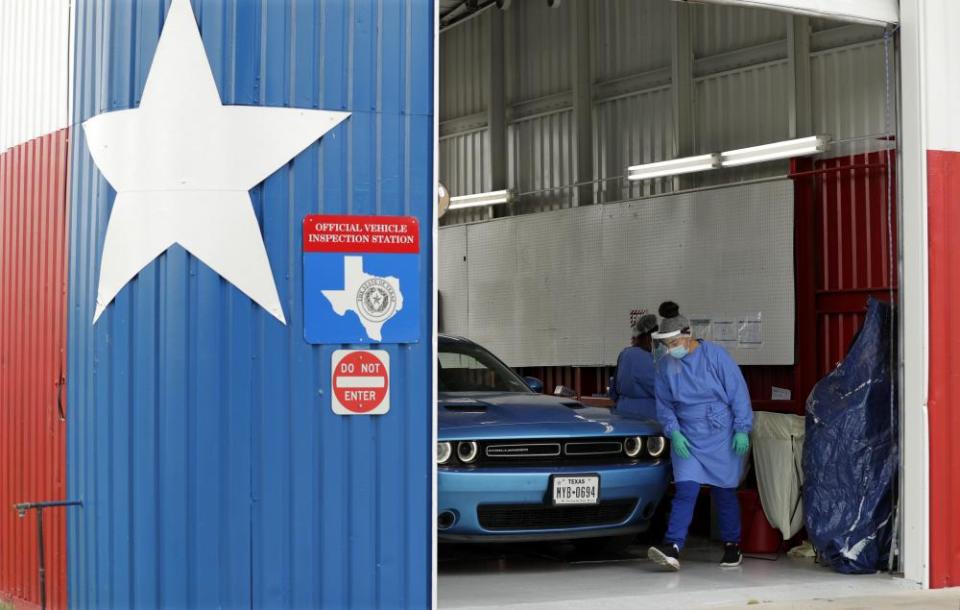Texas border county had 'model' Covid-19 response – then the governor stepped in

Five residents from Starr county on Texas’s southern border died on a single day last week after contracting Covid-19. New infections in the rural border community of around 65,000 people have soared in recent weeks, and two intubated patients had to be airlifted to Dallas and San Antonio when overwhelmed local hospitals couldn’t care for them.
Related: New York City mayor helps paint 'Black Lives Matter' outside Trump Tower
Texas has become one of the US’s new coronavirus hotspots, with new confirmed cases surging to around 14% of the country’s total, when measured by a seven-day average. Elective surgeries were paused this week as the state tries to free up hospital beds for increasing numbers of Covid-19 patients.
But Starr county’s public officials knew months ago that is was especially vulnerable to the coronavirus pandemic: roughly one in three residents lives in poverty, a sizable slice of the population doesn’t have health insurance, and risk factors such as diabetes and obesity prevail. To protect their constituents, who are more than 99% Latino, they acted fast to curtail the contagion.
They developed what officials said was at the time the only drive-through testing site south of San Antonio. They closed schools. They implemented a stay-at-home order, curfew and mandatory face coverings. Only when necessary, they flexed their authority to fine and even jail anyone who flouted the law.
Their strategy worked. The first few coronavirus cases trickled into Starr county in late March, but for three weeks in April, there were no new infections. Before the end of May, weekly tallies of new confirmed positives never once reached double digits. Even seasonal influenza, coughs, colds and fevers that would normally travel through the community suddenly vanished.
“What we did here was a model for the rest of the nation to follow, but it was lost,” said Joel Villarreal, the mayor of Rio Grande City, one of four small cities in the county. “In fact, I think we had it right.”
The inflection point came when Texas governor Greg Abbott unilaterally decided to reopen the state, and stripped local governments of their power in the process. By early May, malls, restaurants, movie theaters, gyms and salons threw open their doors, albeit at limited capacity. Texans lost their fear of the virus as politicians told them it was safe to re-emerge from lockdown, and once masks became politicized, localities could no longer require their use.
“We had local input to close down. But to reopen, we didn’t have any, at all,” said Villarreal.
When local officials contacted the attorney general’s office for clarity about what orders they could continue to enforce, they were informed that the governor’s policies superseded their own. Any attempt to give feedback fell on deaf ears.
What we did here was a model for the rest of the nation to follow, but it was lost. I think we had it right
Joel Villarreal
Both Eloy Vera, the county judge, and Villarreal agreed that the state had to reopen at some point, but they felt Abbott’s approach was too much too fast, and ignored science.
“I think if it would have been slower, we could have kept the curve down,” said Vera. Instead, “our numbers are exponentially increasing, and our hospitals are getting to capacity.”
They’ve tried to devise workarounds to protect their communities, including incentivizing businesses to act responsibly. At Border Town Foods, Amando Peña requires all of his employees to wear masks and face shields. He has lost a handful of customers because he continued to enforce mask-wearing at his stores, even when the law and big-box retailers didn’t.
“I was like, ‘OK, well, that’s all right,’ because our employees need that protection,” Peña said. “They deserve that respect. So I don’t care that some customers left.”
As of last week, Starr county can now mandate face coverings again. But the local government’s other emergency protocols – including a curfew and quotas on gatherings – remain toothless in practice. In Rio Grande City, attorneys are trying to work out what can actually be enforced.
“Here we are, fighting a global pandemic, and we’re having to figure out loopholes on how to keep people safe. That is so ridiculous,” Villarreal said.

Meanwhile, the virus is spreading like wildfire in a community woefully under-equipped to handle an outbreak. About 20 members of a single family contracted Covid-19 after a get-together, as did 30 or 40 attendees at a 500-person wedding, Vazquez said. A local nursing home system has faced a barrage of cases, and altogether, 936 Starr county residents have tested positive for the disease.
“Basically, you have no chance to be admitted in a hospital here in the Valley,” said Jose Vazquez, the county’s health authority. As the situation grows dire, people are starting to realize that “if you were to get sick, nobody can guarantee you any longer that you are going to be doing fine”. Vazquez has also tested positive.
Although Texas’s official count is lagging, the county has already suffered 18 fatalities, according to its own data. Its local hospital only recently expanded the Covid-19 unit from eight beds to 18, and in one day, the unit’s occupancy rocketed from eight to 13.
“We’re the ones down here. We’re the ones who know our community, we know what our needs are,” said Villarreal. “I say this to the governor: you cannot tie my hands at all.”


